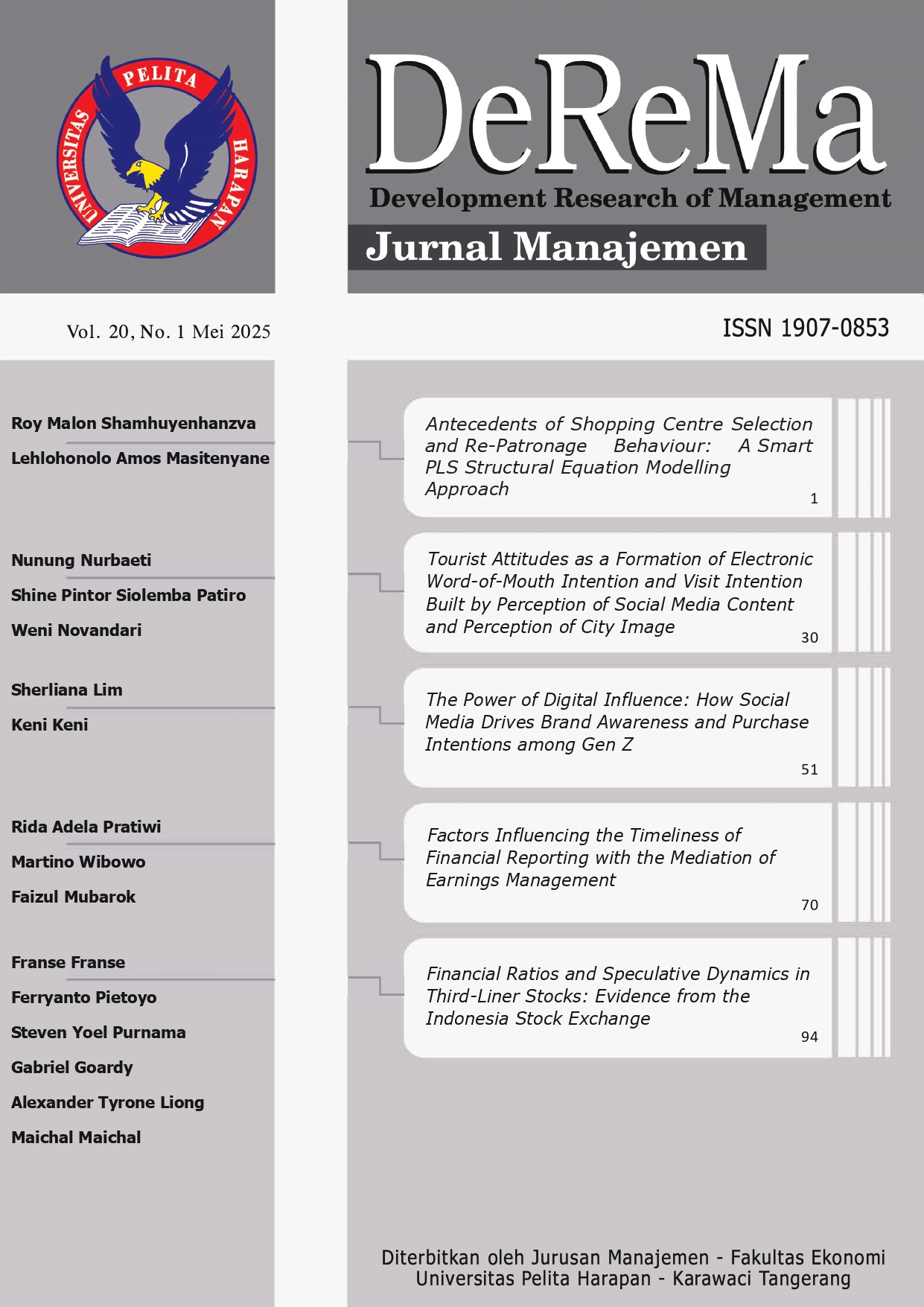FINANCIAL RATIOS AND SPECULATIVE DYNAMICS IN THIRD-LINER STOCKS: EVIDENCE FROM THE INDONESIA STOCK EXCHANGE
DOI:
https://doi.org/10.19166/derema.v20i1.9625Kata Kunci:
Financial Ratios, Third-liner Stock, Speculative Dynamics, Indonesia Stock Exchange (IDX), Random effects modelAbstrak
This study investigates whether traditional financial ratios remain valid predictors of stock prices in speculative market environments, focusing on third-liner stocks listed on the Indonesia Stock Exchange (IDX) from 2012 to 2019. Using panel data regression with a Random Effect Model on 72 companies, the research evaluates the influence of liquidity (Current Ratio), solvency (Debt-to-Equity Ratio), activity (Total Asset Turnover), and profitability (Return on Equity) on stock prices. The results show that only profitability (ROE) and solvency (DER) significantly affect stock prices, while liquidity and activity do not. However, the explanatory power of these ratios is minimal (adjusted R² = 0.02), indicating that stock prices in this segment are largely shaped by speculative dynamics rather than fundamentals. These findings highlight the limitations of conventional financial analysis in high-risk, manipulation-prone markets. The study suggests the need for improved investor education, stricter regulatory oversight, and future research integrating behavioral and sentiment-based indicators to better capture price movements in speculative stocks.
ABSTRAK DALAM BAHASA INDONESIA
Penelitian ini mengkaji apakah rasio keuangan tradisional masih menjadi prediktor yang relevan terhadap harga saham dalam lingkungan pasar yang spekulatif, dengan fokus pada saham third-liner di Bursa Efek Indonesia (BEI) selama periode 2012 hingga 2019. Menggunakan regresi data panel dengan Random Effect Model pada 72 perusahaan, penelitian ini menganalisis pengaruh likuiditas (Current Ratio), solvabilitas (Debt-to-Equity Ratio), aktivitas (Total Asset Turnover), dan profitabilitas (Return on Equity) terhadap harga saham. Hasil penelitian menunjukkan bahwa hanya profitabilitas (ROE) dan solvabilitas (DER) yang berpengaruh signifikan terhadap harga saham, sedangkan likuiditas dan aktivitas tidak berpengaruh. Namun, daya prediksi (adjusted R²) hanya sebesar 0,02, menunjukkan bahwa harga saham pada segmen ini lebih banyak dipengaruhi oleh dinamika spekulatif daripada faktor fundamental. Temuan ini menyoroti keterbatasan analisis keuangan konvensional di pasar yang berisiko tinggi dan rawan manipulasi. Studi ini merekomendasikan peningkatan literasi investor, pengawasan regulasi yang lebih ketat, serta penelitian lanjutan yang mengintegrasikan indikator perilaku dan sentimen pasar untuk menangkap pergerakan harga secara lebih komprehensif.
Referensi
Aaron, A., Koesrindartoto, D. P., & Takashima, R. (2020). Micro-foundation investigation of price manipulation in Indonesian capital market. Emerging Markets Finance and Trade, 56(2), 245–259. https://doi.org/10.1080/1540496X.2018.1497972
Agustin, R., Nurcahyono, N., Sinarasri, A., & Sukesti, F. (2023, May). Financial ratio and stock returns in Indonesia equity markets: A signaling theory approach. In International Conference on Business, Accounting, Banking, and Economics (ICBABE 2022) (pp. 277-292). Atlantic Press.
Arkan, T. (2016). The importance of financial ratios in predicting stock price trends: A case study in emerging markets. Finanse, Rynki Finansowe, Ubezpieczenia, (79), 13-26. Retrieved from https://www.ceeol.com/search/article-detail?id=623339
Asmirantho, E., & Somantri, O. K. (2017). The effect of financial performance on stock price at pharmaceutical sub-sector companies listed in Indonesia Stock Exchange. JIAFE (Jurnal Ilmiah Akuntansi Fakultas Ekonomi), 3(2), 94-107. https://doi.org/10.34204/jiafe.v3i2.778
Ayudya, R., Suwandari, A., & Hartadi, R. (2017). The impacts of fundamental and macroeconomic factors on the stock price of oil palm plantation companies in Indonesia Stock Exchange (IDX). Journal of Economics, Business & Accountancy Ventura, 20(2), 141-148. https://doi.org/10.14414/jebav.v20i2.847
Azam, M., Haseeb, M., Samsi, A. B., & Raji, J. O. (2016). Stock market development and economic growth: Evidences from Asia-4 countries. International Journal of Economics and Financial Issues, 6(3), 1200-1208. Retrieved from https://dergipark.org.tr/en/pub/ijefi/issue/32012/353820#article_cite
Banz, R. W. (1981). The relationship between return and market value of common stocks. Journal of Financial Economics, 9(1), 3–18. https://doi.org/10.1016/0304-405X(81)90018-0
Bauman, W. S., Conover, C. M., & Miller, R. E. (1998). Growth versus value and large-cap versus small-cap stocks in international markets. Financial Analysts Journal, 54(2), 75–89. https://doi.org/10.2469/faj.v54.n2.2168
Bekaert, G., & Harvey, C. R. (1998). Capital markets: An engine for economic growth. The Brown Journal of World Affairs, 5(1), 33-53. Retrieved from https://www.jstor.org/stable/24589952
Black, F. (1993). Beta and return. The Journal of Portfolio Management, 20(1), 8–18. https://doi.org/10.3905/jpm.1993.409462
Edelweiss, A., Emmanuel, J., & Siregar, R. (2024). Responsibility of influencers who conduct stock POMMs as a law enforcement measure for investors. Jurnal Ilmiah Advokasi, 12(1), 124-138. https://doi.org/10.36987/jiad.v12i1.4855
Fahlevie, R. A., Oktasari, E., Nurmawati, B., Setiawan, P. A. H., & Dimalouw, J. A. (2022). Pump and dump criminal overview according to capital market law No. 8 year 1995. Awang Long Law Review, 5(1), 167-179. https://doi.org/10.56301/awl.v5i1.547
Gujarati, D. N., & Porter, D. C. (2009). Basic econometrics (5th ed.). McGraw-Hill.
Hasibuan, G. L., Muda, I., & Erwin, K. (2022). Detection of financial statement fraud on property and real estate companies listed on IDX. Int. J. Res. Rev, 9(12).
Herawati, A., & Putra, A. S. (2018). The influence of fundamental analysis on stock prices: The case of food and beverage industries. European Research Studies, 21(3), 316-326. Retrieved from https://www.ersj.eu/dmdocuments/2018_XXI_3_24.pdf
Indonesia Stock Exchange. (n.d.). Ringkasan saham. Retrieved November 22, 2024, from https://www.idx.id/id/data-pasar/ringkasan-perdagangan/ringkasan-saham
Johnston, J., & DiNardo, J. (1997). Econometric methods (4th ed.). McGraw-Hill.
Juwita, C. P., & Diana, N. (2020). The effect of debt to equity ratio and return on equity on stock price in Jakarta Islamic Index companies on Indonesia Stock Exchange period 2015-2019. Management Analysis Journal, 9(4), 434-441. Retrieved from http://maj.unnes.ac.id/
Kuncara, T. (2022). Financial statement fraud detection with Beneish M-Score analysis on SOE companies in the mineral and coal industry sector listed on IDX. East Asian Journal of Multidisciplinary Research, 1(2), 49-58. Retrieved from https://www.neliti.com/publications/555114/financial-statement-fraud-detection-with-beneish-m-score-analysis-on-soe-compani#cite
Lesmana, A. S. (2023). Identifikasi bull and bear market di pasar modal syariah Indonesia: Pendekatan Markov-switching. DeReMa (Development Research of Management), 18(1), 1–15. https://doi.org/10.19166/derema.v18i1.6643
Muktiadji, N., & Pamungkas, B. (2022). The effect of financial ratio on stock price of banks listed on the Indonesia Stock Exchange (IDX). Asian Journal of Economics, Business and Accounting, 22(24), 232-240. https://doi.org/10.9734/AJEBA/2022/v22i24910
Mushinada, V. N. C. (2020). Are individual investors irrational or adaptive to market dynamics? Journal of Behavioral and Experimental Finance, 25, 100243. https://doi.org/10.1016/j.jbef.2019.100243
Nanayakkara, N. S., Nimal, P. D., & Weerakoon, Y. K. (2019). Behavioural asset pricing: A review. https://doi.org/10.32479/ijefi.8190
Ngare, E., Nyamongo, E. M., & Misati, R. N. (2014). Stock market development and economic growth in Africa. Journal of Economics and Business, 74, 24-39. https://doi.org/10.1016/j.jeconbus.2014.03.002
Noviyanti, E. A., Rahayu, C. W. E., & Rahmawati, C. H. T. (2021). Financial performance and stock price: Another review on banks listed in Indonesia Stock Exchange. Journal of Management and Business Environment (JMBE), 3(1), 70-88. https://doi.org/10.24167/jmbe.v3i1.3438
Nugraha, K. C., & Artini, L. G. S. (2022). The effect of financial performance on stock prices of automotive and component sub sector companies in the Indonesia Stock Exchange. European Journal of Business and Management Research, 7(4), 327-331. https://doi.org/10.24018/ejbmr.2022.7.4.1595
Öğüt, H., Doğanay, M. M., & Aktaş, R. (2009). Detecting stock-price manipulation in an emerging market: The case of Turkey. Expert Systems with Applications, 36(9), 11944-11949. https://doi.org/10.1016/j.eswa.2009.03.065
Pandey, A., & Sehgal, S. (2016). Explaining size effect for Indian stock market. Asia-Pacific Financial Markets, 23, 45-68. https://doi.org/10.1007/s10690-015-9208-0
Patel, J. B. (2012). A further analysis of small firm stock returns. Managerial Finance, 38(7), 653-659. https://doi.org/10.1108/03074351211233113
Pratama, I. O., Wahyuningtias, E., Kholis, N., Sobaya, S., & Yulianti, R. T. (2022). Role of influencer contents on sharia stock market activities in Indonesia during the COVID-19 pandemic. KnE Social Sciences, 56-68. https://doi.org/10.18502/kss.v7i10.11344
Pražák, T., & Stavárek, D. (2017). The effect of financial ratios on the stock price development. Working Paper in Interdisciplinary Economics and Business Research no. 43. Silesian University in Opava, School of Business Administration in Karviná.
Purwanto, S. (2014). The possibility of manipulated IPO underpricing and post-IPO stock return: Empirical study on Jakarta Stock Exchange 2009-2012. The Indonesian Capital Market Review, 6(2), 5. https://doi.org/10.21002/icmr.v6i2.3593
Puspitaningtyas, Z. (2019). Empirical evidence of market reactions based on signaling theory in Indonesia Stock Exchange. Investment Management and Financial Innovations, 16(2), 66-77. http://dx.doi.org/10.21511/imfi.16(2).2019.06
Samsi, S. M., Cheok, C. K., & Yusof, Z. (2019). Financial crisis, stock market and economic growth. Journal of Southeast Asian Economies, 36(1), 37-56. Retrieved from https://www.jstor.org/stable/26664252
Santosa, P. W., & Huda, N. (2020). Studi efisiensi pasar modal syariah Indonesia: Over-reaksi atau momentum? DeReMa (Development Research of Management), 15(2), 187–200. https://doi.org/10.19166/derema.v15i2.2317
Sergi, B. S., Wongkar, N., & Suhariono, K. L. (2024). Manipulation and financial market misconduct in Indonesia. The American Economist, 05694345241256233. https://doi.org/10.1177/05694345241256233
Sudarmaji, E., Ambarwati, S., Hubbansyah, A. K., & Astuti, S. B. (2020). Event study of IPO in Indonesia: Pump-and-dump & flipping strategy analysis. Journal of Accounting and Finance Management, 1(2), 76-87. https://doi.org/10.38035/jafm.v1i1.14
Umboh, J. E., & Atahau, A. D. R. (2019). Investment interest and consumptive behaviour of student investors: Between rationality and irrationality. JDM (Jurnal Dinamika Manajemen), 10(1), 14-31. https://www.researchgate.net/publication/338747867_Investment_Interest_and_Consumptive_Behaviour_of_Student_Investors_Between_Rationality_and_Irrationality
Wulansari, T., Sulastri, S., Widiyanti, M., & Adam, M. (2023). The effect of financial ratio on stock price in telecommunications sector companies listed on the Indonesia stock exchange. International Journal of Business, Economics & Management, 6(1), 1-9. https://doi.org/10.21744/ijbem.v6n1.2058
Yang, F., Yang, H., & Yang, M. (2014, October). Discrimination of China's stock price manipulation based on primary component analysis. In 2014 International Conference on Behavioral, Economic, and Socio-Cultural Computing (BESC2014) (pp. 1-5). IEEE. https://doi.org/10.1109/BESC.2014.7059519
Yasar, B., Martin, T., & Kiessling, T. (2020). An empirical test of signalling theory. Management Research Review, 43(11), 1309-1335. https://doi.org/10.1108/MRR-08-2019-0338
Ye, J., Li, D., & Cao, Y. (2020). Investor irrational selection bias in stock market based on cognitive psychology: Evidence from herding behaviour. Revista Argentina de Clínica Psicológica, 29(1), 90. https://doi.org/10.24205/03276716.2020.13
Unduhan
Diterbitkan
Terbitan
Bagian
Lisensi
Hak Cipta (c) 2025 Franse franse, Ferryanto Pietoyo, Steven Yoel Purnama, Gabriel Goardy, Alexander Tyrone Liong, Maichal Maichal

Artikel ini berlisensiCreative Commons Attribution-ShareAlike 4.0 International License.
Authors who publish with this journal agree to the following terms:
1) Authors retain copyright and grant the journal right of first publication with the work simultaneously licensed under a Creative Commons Attribution License (CC-BY-SA 4.0) that allows others to share the work with an acknowledgement of the work's authorship and initial publication in this journal.
2) Authors are able to enter into separate, additional contractual arrangements for the non-exclusive distribution of the journal's published version of the work (e.g., post it to an institutional repository or publish it in a book), with an acknowledgement of its initial publication in this journal.
3) Authors are permitted and encouraged to post their work online (e.g., in institutional repositories or on their website). The final published PDF should be used and bibliographic details that credit the publication in this journal should be included.





